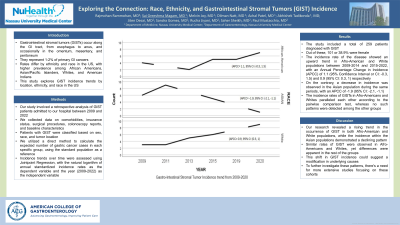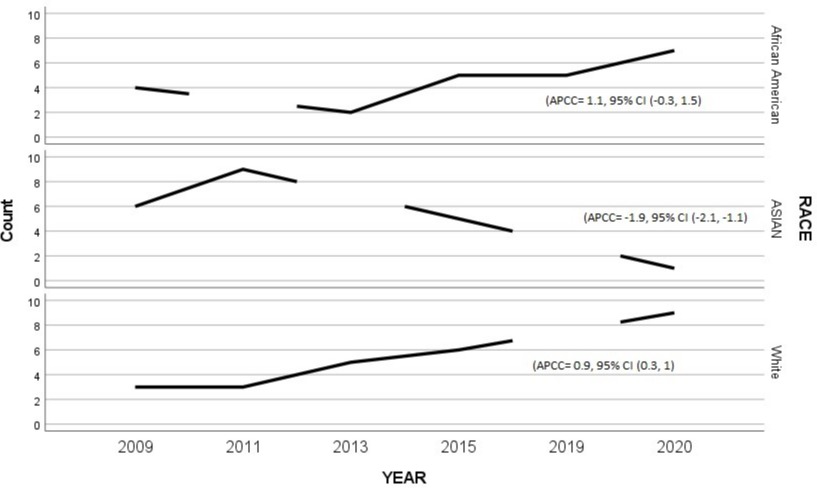Monday Poster Session
Category: Stomach
P2716 - Exploring the Connection: Race, Ethnicity, and Gastrointestinal Stromal Tumors Incidence
Monday, October 23, 2023
10:30 AM - 4:15 PM PT
Location: Exhibit Hall

Has Audio

Sai Greeshma Magam, MD
Nassau University Medical Center
East Meadow, NY
Presenting Author(s)
Rajmohan Rammohan, MD, Melvin Joy, MD, Sai Greeshma Magam, MD, Dilman Natt, MD, Tulika Saggar, MD, Achal Patel, MD, Abhishek Tadikonda, MD, Jiten Desai, MD, Sandra Gomez, MD, Rucha Jiyani, MD, Saher Sheikh, MD, Paul Mustacchia, MD, MBA
Nassau University Medical Center, East Meadow, NY
Introduction: Gastrointestinal stromal tumors (GISTs) occur along the GI tract, from esophagus to anus, and occasionally in omentum, mesentery, and peritoneum. They represent 1-2% of primary GI cancers. Rates differ by ethnicity and race in the US, with higher prevalence among African Americans, Asian/Pacific Islanders, Whites, and American Indians. This study explores GIST incidence trends by location, ethnicity, and race in the US.
Methods: Our study involved a retrospective analysis of GIST patients admitted to our hospital between 2009 and 2022. We collected data on comorbidities, insurance status, surgical procedures, colonoscopy reports, and baseline characteristics. Patients with GIST were classified based on sex, race, and tumor location. We utilized a direct method to calculate the expected number of gastric cancer cases in each specific group, using the standard population as a reference. Incidence trends over time were assessed using Jointpoint Regression, with the natural logarithm of annual standardized incidence rates as the dependent variable and the year (2009-2022) as the independent variable.
Results: The study included a total of 259 patients diagnosed with GIST. Out of these, 101 or 38.9% were female. The incidence rate of the disease showed an upward trend in Afro-American and White populations between 2009-2014 and 2015-2022, with an Annual Percentage Change in Incidence (APCC) of 1.1 (95% Confidence Interval or CI: -0.3, 1.5) and 0.9 (95% CI: 0.3, 1) respectively. On the contrary, a decrease in incidence was observed in the Asian population during the same periods, with an APCC of -1.9 (95% CI: -2.1, -1.1). The incidence rates of GISTs in Afro-Americans and Whites paralleled each other according to the pairwise comparison test, whereas no such patterns were detected among the other groups.
Discussion: Our research revealed a rising trend in the occurrence of GIST in both Afro-American and White populations, while the incidence within the Asian populations demonstrated a declining pattern. Similar rates of GIST were observed in Afro-Americans and Whites, yet differences were apparent in the rest of the groups. This shift in GIST incidence could suggest a modification in underlying causes. To further investigate these patterns, there's a need for more extensive studies focusing on these cohorts.

Disclosures:
Rajmohan Rammohan, MD, Melvin Joy, MD, Sai Greeshma Magam, MD, Dilman Natt, MD, Tulika Saggar, MD, Achal Patel, MD, Abhishek Tadikonda, MD, Jiten Desai, MD, Sandra Gomez, MD, Rucha Jiyani, MD, Saher Sheikh, MD, Paul Mustacchia, MD, MBA. P2716 - Exploring the Connection: Race, Ethnicity, and Gastrointestinal Stromal Tumors Incidence, ACG 2023 Annual Scientific Meeting Abstracts. Vancouver, BC, Canada: American College of Gastroenterology.
Nassau University Medical Center, East Meadow, NY
Introduction: Gastrointestinal stromal tumors (GISTs) occur along the GI tract, from esophagus to anus, and occasionally in omentum, mesentery, and peritoneum. They represent 1-2% of primary GI cancers. Rates differ by ethnicity and race in the US, with higher prevalence among African Americans, Asian/Pacific Islanders, Whites, and American Indians. This study explores GIST incidence trends by location, ethnicity, and race in the US.
Methods: Our study involved a retrospective analysis of GIST patients admitted to our hospital between 2009 and 2022. We collected data on comorbidities, insurance status, surgical procedures, colonoscopy reports, and baseline characteristics. Patients with GIST were classified based on sex, race, and tumor location. We utilized a direct method to calculate the expected number of gastric cancer cases in each specific group, using the standard population as a reference. Incidence trends over time were assessed using Jointpoint Regression, with the natural logarithm of annual standardized incidence rates as the dependent variable and the year (2009-2022) as the independent variable.
Results: The study included a total of 259 patients diagnosed with GIST. Out of these, 101 or 38.9% were female. The incidence rate of the disease showed an upward trend in Afro-American and White populations between 2009-2014 and 2015-2022, with an Annual Percentage Change in Incidence (APCC) of 1.1 (95% Confidence Interval or CI: -0.3, 1.5) and 0.9 (95% CI: 0.3, 1) respectively. On the contrary, a decrease in incidence was observed in the Asian population during the same periods, with an APCC of -1.9 (95% CI: -2.1, -1.1). The incidence rates of GISTs in Afro-Americans and Whites paralleled each other according to the pairwise comparison test, whereas no such patterns were detected among the other groups.
Discussion: Our research revealed a rising trend in the occurrence of GIST in both Afro-American and White populations, while the incidence within the Asian populations demonstrated a declining pattern. Similar rates of GIST were observed in Afro-Americans and Whites, yet differences were apparent in the rest of the groups. This shift in GIST incidence could suggest a modification in underlying causes. To further investigate these patterns, there's a need for more extensive studies focusing on these cohorts.

Figure: Gastro-Intestinal Stromal Tumor Incidence trend from 2009-2020
Disclosures:
Rajmohan Rammohan indicated no relevant financial relationships.
Melvin Joy indicated no relevant financial relationships.
Sai Greeshma Magam indicated no relevant financial relationships.
Dilman Natt indicated no relevant financial relationships.
Tulika Saggar indicated no relevant financial relationships.
Achal Patel indicated no relevant financial relationships.
Abhishek Tadikonda indicated no relevant financial relationships.
Jiten Desai indicated no relevant financial relationships.
Sandra Gomez indicated no relevant financial relationships.
Rucha Jiyani indicated no relevant financial relationships.
Saher Sheikh indicated no relevant financial relationships.
Paul Mustacchia indicated no relevant financial relationships.
Rajmohan Rammohan, MD, Melvin Joy, MD, Sai Greeshma Magam, MD, Dilman Natt, MD, Tulika Saggar, MD, Achal Patel, MD, Abhishek Tadikonda, MD, Jiten Desai, MD, Sandra Gomez, MD, Rucha Jiyani, MD, Saher Sheikh, MD, Paul Mustacchia, MD, MBA. P2716 - Exploring the Connection: Race, Ethnicity, and Gastrointestinal Stromal Tumors Incidence, ACG 2023 Annual Scientific Meeting Abstracts. Vancouver, BC, Canada: American College of Gastroenterology.
